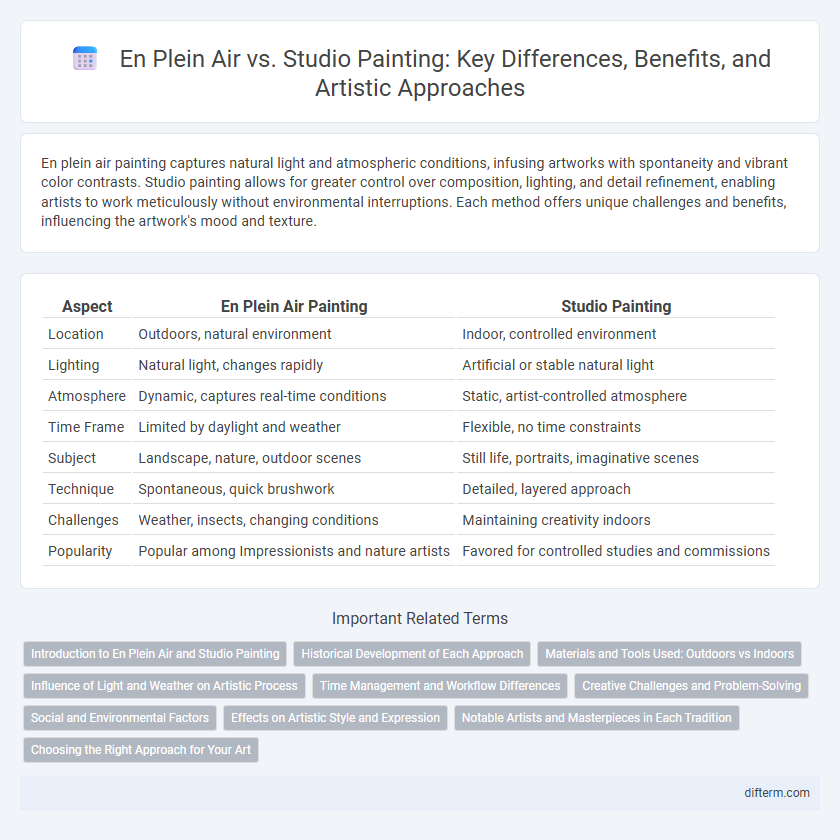En plein air painting captures natural light and atmospheric conditions, infusing artworks with spontaneity and vibrant color contrasts. Studio painting allows for greater control over composition, lighting, and detail refinement, enabling artists to work meticulously without environmental interruptions. Each method offers unique challenges and benefits, influencing the artwork's mood and texture.
Table of Comparison
| Aspect | En Plein Air Painting | Studio Painting |
|---|---|---|
| Location | Outdoors, natural environment | Indoor, controlled environment |
| Lighting | Natural light, changes rapidly | Artificial or stable natural light |
| Atmosphere | Dynamic, captures real-time conditions | Static, artist-controlled atmosphere |
| Time Frame | Limited by daylight and weather | Flexible, no time constraints |
| Subject | Landscape, nature, outdoor scenes | Still life, portraits, imaginative scenes |
| Technique | Spontaneous, quick brushwork | Detailed, layered approach |
| Challenges | Weather, insects, changing conditions | Maintaining creativity indoors |
| Popularity | Popular among Impressionists and nature artists | Favored for controlled studies and commissions |
Introduction to En Plein Air and Studio Painting
En plein air painting emphasizes capturing natural light and atmosphere by working outdoors, directly observing the landscape to achieve vibrant, dynamic compositions. Studio painting allows artists to control environment, lighting, and materials, facilitating detailed work and experimentation with complex techniques. Both methods offer distinct advantages in expression, with en plein air fostering spontaneity and studio painting enabling precision.
Historical Development of Each Approach
En plein air painting originated in the 19th century with the Impressionists, who sought to capture natural light and atmospheric conditions directly from outdoor settings, revolutionizing art by emphasizing spontaneity and color vibrancy. Studio painting, rooted in classical traditions, allowed artists to meticulously develop compositions and details within controlled environments, fostering academic rigor and precise technique. The historical development of both approaches reflects evolving artistic priorities, with en plein air challenging studio conventions and expanding expressive possibilities in modern art.
Materials and Tools Used: Outdoors vs Indoors
En plein air painting requires portable materials such as lightweight easels, compact paint tubes, and all-weather brushes designed for outdoor durability, often favoring oil or acrylics that dry relatively quickly under natural light. Studio painting allows use of a broader range of tools including large canvases, multiple paint types like oil, acrylic, or watercolor, and specialized equipment such as palette knives and various textured mediums optimized for controlled indoor environments. The choice of materials and tools directly impacts the artist's technique, with en plein air favoring mobility and weather resistance, while studio painting supports complexity and experimentation with textures and layers.
Influence of Light and Weather on Artistic Process
En plein air painting allows artists to capture the transient effects of natural light and dynamic weather conditions, creating authentic and vivid representations of the environment. In contrast, studio painting offers controlled lighting and stable conditions, enabling detailed refinement and experimentation without external interruptions. The influence of natural elements in plein air work fosters spontaneity and a direct emotional response, while studio settings facilitate meticulous composition and color adjustment.
Time Management and Workflow Differences
En plein air painting requires artists to work swiftly, capturing natural light and changing environmental conditions within limited time frames, which demands efficient time management and rapid decision-making. Studio painting offers a controlled environment where artists can work at a more deliberate pace, allowing for intricate details and adjustments without the pressure of external factors. Workflow in plein air emphasizes immediacy and spontaneity, while studio painting prioritizes layered techniques and extended refinement.
Creative Challenges and Problem-Solving
En plein air painting demands artists to adapt quickly to changing natural light, weather conditions, and evolving landscapes, fostering spontaneous creativity and immediate problem-solving skills. Studio painting allows for controlled environments where artists can deliberate over composition and detail without environmental disruptions, encouraging meticulous refinement and conceptual depth. Both approaches challenge artists to innovate within their constraints, enhancing technical proficiency and creative resilience.
Social and Environmental Factors
En plein air painting captures natural light and environmental conditions, promoting direct engagement with landscapes and weather, which reflects social values of authenticity and connection to nature. Studio painting allows controlled settings, enabling artists to experiment with composition and emotion without environmental distractions, often influenced by urbanization and societal shifts toward interior workspaces. Socially, en plein air art fosters community interaction through shared outdoor experiences, while studio work supports individual introspection and detailed refinement.
Effects on Artistic Style and Expression
En plein air painting captures natural light and atmospheric changes, resulting in dynamic brushstrokes and vibrant color palettes that enhance spontaneity and realism. Studio painting offers controlled conditions, allowing for meticulous detail, layered textures, and deliberate composition, which fosters a refined and introspective artistic style. The choice between these methods significantly influences an artist's expressive approach, balancing immediacy and precision in visual storytelling.
Notable Artists and Masterpieces in Each Tradition
Notable en plein air artists include Claude Monet and Camille Pissarro, whose masterpieces like Monet's "Impression, Sunrise" capture natural light and atmosphere directly from outdoor settings. In contrast, studio painting features artists such as Johannes Vermeer and Francisco Goya, who created detailed, meticulously composed works like Vermeer's "Girl with a Pearl Earring" under controlled indoor conditions. Each tradition offers unique techniques and artistic approaches that have significantly influenced the development of Western art history.
Choosing the Right Approach for Your Art
En plein air painting captures natural light and dynamic landscapes with immediacy, offering vibrant color and atmosphere that studio work often lacks. Studio painting allows for controlled conditions, enabling detailed refinement and prolonged focus on complex compositions. Artists should consider their subject, desired mood, and workflow flexibility when choosing between spontaneous outdoor sessions or meticulous indoor creation.
En plein air vs Studio painting Infographic

 difterm.com
difterm.com